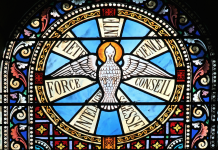
by Lisa Mladinich
Children are about seven when they receive the sacrament of reconciliation for the first time. Around this time they are more self-aware than ever before, so when they make a mistake, they experience shame. Out of sensitivity to their budding consciences, handle lessons on sin and forgiveness with great care. Here are some examples you can share with your students.
• God’s laws: Car manuals instruct us how to best take care of our cars so they run well. The Ten Commandments are God’s “user’s manual” for our souls. When we follow the instructions we are happy and holy!
• Behind each “no” is a bigger “yes.” Recall that our parents teach us about dangers like hot stoves and busy streets when we are small, and explain that the “yes” behind their “no” is the way they love us and want us to be happy and safe. In the same way, behind every no in the Commandments is a much bigger yes that helps us to journey safely and happily home to heaven.
• Commandment chat: We don’t destroy life; we are pro-life! We love others and help to carry their burdens at every stage, making life a shared adventure full of kindness and friendship. We don’t steal or lie; we act with honor and honesty, helping the world to be a better place. Ask the children for their own “yes” examples from the Commandments. Emphasize God’s infinite mercy. Be joyful!
Teach:
• It is Jesus who forgives our sins. The priest is in persona Christi (the person of Christ) when he absolves us from our sins.
• Reconciliation is about restoring our relationships with God and others.
• There’s a big difference between deliberate sin and accidents.
• Venial sins, while less serious, make it harder to love God and others.
• Mortal sins are very serious, done with full understanding, and intent. They hurt our souls and block God’s grace.
• God can forgive anything!
• The priest is strictly forbidden from talking about our sins to anyone else—ever.
Prepare:
• Practice the Act of Contrition in class and provide laminated copies on brightly colored paper for students to take home (they are harder to misplace). Ask parents to practice with them.
• Invite a priest to visit, or borrow the purple stole he wears to hear confessions, and show children the gold embroidered cross in its center which the priest kisses before “putting on Christ” to hear confessions. Tell them that when he removes the stole, he forgets our sins.
• Visit the confessional together, and demonstrate how hard it is to hear someone speaking softly from inside.
• Repeatedly walk the children through the steps of making a good confession according to parish guidelines. You want them to be confident.
• Share Bible stories about forgiveness: (i.e., Jonah, prodigal son, lost sheep).
Most important, go to confession yourself! We need every grace to awaken children’s hearts to the beauty and power of this soul-cleansing, empowering sacrament.
Lisa Mladinich is the author of the “Be an Amazing Catechist” series from Our Sunday Visitor. She is the owner of AmazingCatechists.com and blogs at “Water into Wine” at Patheos.com.
Helpful resources
Child’s Examination of Conscience: AmazingCatechists.com/2014/11/examination-of-conscience-for-kids
Penance Bingo Cards and Key: AmazingCatechists.com/2014/11/review-terms-with-penance-bingo
Activities: SacredHeartHouston.org/PenanceEucharist-Activities
Copyright 2015, Bayard, Inc. All rights reserved. This article is protected by United States copyright and other intellectual property laws and may not be reproduced, rewritten, distributed, redisseminated, transmitted, displayed, published or broadcast, directly or indirectly, in any medium without the prior written permission of Bayard, Inc.
This article was written by the Catechist Staff and appeared in Catechist magazine, July 2015.
Image Credit: Shutter Stock 515108215




